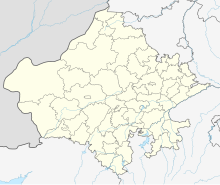Draft:Siege of Ranthambore (1291)
 | Review waiting, please be patient.
This may take 2 months or more, since drafts are reviewed in no specific order. There are 1,813 pending submissions waiting for review.
Where to get help
How to improve a draft
You can also browse Wikipedia:Featured articles and Wikipedia:Good articles to find examples of Wikipedia's best writing on topics similar to your proposed article. Improving your odds of a speedy review To improve your odds of a faster review, tag your draft with relevant WikiProject tags using the button below. This will let reviewers know a new draft has been submitted in their area of interest. For instance, if you wrote about a female astronomer, you would want to add the Biography, Astronomy, and Women scientists tags. Editor resources
Reviewer tools
|
| This is a draft article. It is a work in progress open to editing by anyone. Please ensure core content policies are met before publishing it as a live Wikipedia article. Find sources: Google (books · news · scholar · free images · WP refs) · FENS · JSTOR · TWL Last edited by Citation bot (talk | contribs) 16 hours ago. (Update)
This draft has been submitted and is currently awaiting review. |
| Siege of Ranthambore (1291) | |||||||||
|---|---|---|---|---|---|---|---|---|---|
| |||||||||
| Belligerents | |||||||||
|
| Chauhans of Ranthambore | ||||||||
| Commanders and leaders | |||||||||
|
| Hammiradeva | ||||||||
Ranthambore on Map | |||||||||
The Siege of Ranthambore in 1291 was one of the important military operations during the time of Jalaluddin Khalji who was the first ruler of the Khalji dynasty of Delhi Sultanate.[1] The sultan planned an expedition with the goal of capturing Ranthambore Fort which was under the control of Hammirdeva ruler of the Chauhan dynasty.[2] Realising he cannot capture the fort and not wanting to lose more lives of his soldiers and realizing that further conflict was simply pointless, Jalaluddin Khalji made the rare decision to restore his forces, denoting a strategic retreat.[3][4][5]
Siege
[edit]Ranthambore was a unique fortress to claim as it was geographically placed on the top of a hill and was fortified by numerous others. After Jalaluddin Khalji combed through Jhain, he ordered the construction of warfare structures and tunnels in addition to ordering his soldiers to commence construction procedures in order to scale the fortified walls of the fort.[1] However, renowned historian Ziauddin Barani was surprised with the fact that Jalaluddin eventually ordered his forces to withdraw as he refused to see any more Muslim deaths, something that many did not forget when he explained his logic claiming that he would rather his soldiers remain alive instead of risking their lives for a piece of land.[1][2] He accepted the fact that he can't capture this fort. For local rulers, this would mean encouragement in their crusades, a notion frowned upon by his nephew Ahmad Chap who praised history’s rulers such as Mahmud of Ghazni and Sanjar.[1][2][4] They both, however, differed in their reasoning to compare anything as Jalal-ud-din asserted that the circumstances were different.[1][2][3][4]
See also
[edit]- Capture of Jhain
- Delhi Sultanate
- Khalji Revolution
- Alauddin Khalji's conquest of Ranthambore
- Chahamanas of Ranastambhapura
References
[edit]Category:Alauddin Khalji Category:Battles involving the Delhi Sultanate Category:Battles involving the Rajputs Category:History of Rajasthan Category:13th century in India Category:1291 in Asia Category:Conflicts in 1291
- ^ a b c d e Srivastav Ashoka .k (1981). Khalji Sultans In Rajasthan. pp. 36–39.
- ^ a b c d A Comprehensive History of India: The Delhi Sultanat (A.D. 1206-1526), ed. by Mohammad Habib and Khaliq Ahmad Nizami. People's Publishing House. 1970. p. 319.
- ^ a b Sharma, Dasharatha (1975). Early Chauhān Dynasties: A Study of Chauhān Political History, Chauhān Political Institutions, and Life in the Chauhān Dominions, from 800 to 1316 A.D. Motilal Banarsidass. p. 109. ISBN 978-0-8426-0618-9.
- ^ a b c Lal, K. s (1950). History Of The Khaljis (1290-1320). pp. 35–36.
- ^ Hooja, Rima (2006). A History of Rajasthan. Rupa & Company. p. 299. ISBN 978-81-291-0890-6.

